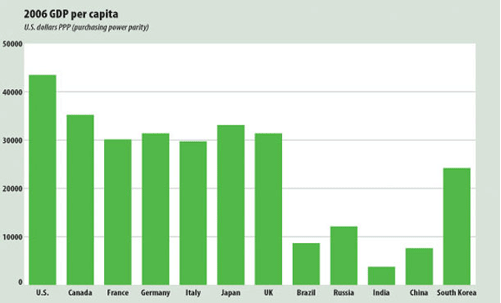
Trouble Ahead, Trouble Behind
American.gov | 2013-01-24 13:52

While the United States has the highest GDP per capita among major economies, its distribution of income is the most unequal.
Despite its many successes, the U.S. economy faces important challenges
(The following article is taken from the U.S. Department of State publication, USA Economy in Brief.)
The U.S. economy has not only fundamental strengths but also fundamental problems.
The U.S. Central Intelligence Agency summarizes economic conditions in nearly 200 countries. Here is what its 2007 World Factbook says about the home country: "Long-term problems include inadequate investment in economic infrastructure, rapidly rising medical and pension costs of an aging population, sizable trade and budget deficits, and stagnation of family income in the lower economic groups."
Like U.S. economic strengths, however, U.S. economic problems evolve over time.
Consider income inequality. The United States is No. 10 in gross domestic product per person (adjusted for what the same money actually affords in different countries), at about $43,500 in 2006, behind Bermuda, Luxembourg, Jersey, Equatorial Guinea, United Arab Emirates, Norway, Guernsey, the Cayman Islands, and Ireland, but ahead of all other major economies.
The distribution of income in the United States, however, is the most unequal of all major economies. It is becoming more so over decades. In 2004, according to the Congressional Budget Office, the top fifth of U.S. households earned 53.5 percent of all U.S. income, while the bottom fifth earned only 4.1 percent. The top 1 percent alone earned 16.3 percent of all income, twice the proportion of the 1960s-1970s.
While income went up some for all U.S. households, the biggest gains went to the group of top earners.
"The bottom 60 percent of households have seen gains of less than 10 percent in real terms between 1986 and 2005, while incomes for the top quintile have risen 32.5 percent and those for the top 5 percent have risen 49 percent," the Council on Competitiveness says.

Multinational companies produce goods worldwide. Pictured here, a Nike athletic shoe factory in Vietnam. (© AP Images/Richard Vogel)
What is the reason for this two-tier labor market? The prevailing view is that those at the bottom lack the education or skills of those at the top. Struggling to grapple with technological change and to compete against low-wage workers elsewhere in the global economy, they fail to get comparable pay raises and other benefits.
Yet the statistics conceal dynamic changes going on in income mobility; the incomes of many Americans rise and fall over time. From 1989 to 1998, for example, 47 percent of households in the bottom fifth moved up into one of the other groups, and 47 percent of those in the top fifth moved down. Among all households, about 60 percent moved up or down from one group to another over those years.
Still, U.S. policy makers recognize the potential damage to the economy from stagnant incomes for people at the bottom.
"If we did not place some limits on the downside risks to individuals affected by economic change," Federal Reserve Chairman Ben Bernanke said in a 2007 speech, "the public at large might become less willing to accept the dynamism that is so essential to economic progress."
Americans have long held ambivalent feelings about the rich and famous. Aggressive businessmen have at different times been praised as captains of industry and scorned as robber barons. These days some of the wealthiest of the wealthy are celebrities in entertainment and sports, supported by a public willing to pay for their unique star qualities.
And how does the U.S. energy problem figure into all this?
Share this page



















